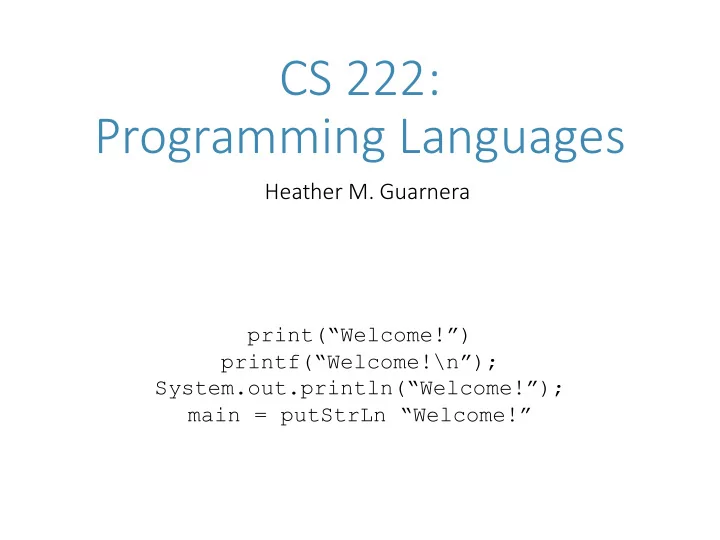

CS 222: Programming Languages Heather M. Guarnera print(“Welcome!”) printf(“Welcome!\n”); System.out.println(“Welcome!”); main = putStrLn “Welcome!”
4 (or 5) generations of programming languages • 1GL 1GL : machine code • 2GL 2GL : symbolic assemblers • 3GL 3GL : (machine-independent) imperative languages • Ex: FORTRAN, Pascal, C ... • 4GL 4GL : domain specific application generators • Scinapse a generator for mathematical modeling software • Mousetrap generates efficient real-time code for Motorola • R, SAS, SPSS, XSLT, Xquery … • 5GL 5GL : AI languages … Each generation is at a higher level of abstraction 2
Performance vs. ease of writing Low-level Low-level language: Assembly • Native (or close to) to physical machine Fortran • Efficient C Prolog High-level language: Ada • Higher abstraction C++ • Easier to read / write Java • Tradeoff with efficiency Python High-level 3
Common ideas in modern imperative languages • Extensive features • Rich type system • Mechanisms to support (in varying degree) • Procedural programming • Object-oriented programming • Concurrent programming • Generic programming • Abstractions • Information hiding 4
How do programming languages differ? Common constructs basic data types (numbers, etc.); variables; expressions; statements; keywords; control constructs; procedures; comments; errors ... Uncommon constructs type declarations; special types (strings, arrays, matrices, ...); concurrency constructs; packages/modules; objects; general functions; generics; ... 5
Programming paradigms A programming language is a problem solving tool. Imperative style program = algorithms + data Good for decomposition Functional style program = functions ⚬ functions Good for reasoning Logic programming style program = facts + rules Good for searching Object-oriented style program = objects + messages Good for modeling 6
Imperative Paradigm • A program is: a sequence of state -changing actions • Manipulate an abstract machine with • variables that name memory locations • arithmetic and logical operations • reference, evaluate, assign operations • explicit control flow statements • Fits the Von Neumann architecture closely • Key operations: assignment, if, while 7
Imperative Paradigm Task: Sum up twice each number from 1 to N. SUM = 0 Fortran Fo DO 11 K=1,N SUM = SUM + 2*K 11 CONTINUE sum = 0; C for (k = 1; k <= n; ++k) sum += 2*k; sum := 0; Pa Pascal for k := 1 to n do sum := sum + 2*k; 8
Functional Paradigm • A program is: a composition of functions on data • Characteristics (in pure form): • Name values, not memory locations • Bind rather than assign • A variable is a table entry not a memory location • Value binding through parameter passing • Recursion rather than iteration • Key operations: function application and function abstraction • Based on lambda calculus 9
Functional Paradigm Sc Scheme ( define (sum n) ( if (= n 0) 0 (+ (* n 2) (sum (- n 1))) ) ) (sum 4) evaluates to 20 10
Logic Paradigm • A program is: a formal logical specification of a problem • Characteristics (in pure form): • Programs say what properties the solution must have, not how to find it • Solutions are obtained through a specialized form of theorem-proving • Key operations: unification and non-deterministic search • Based on first order predicate logic 11
Logic Paradigm Pr Prolog sum(0,0). sum(N,S) :- N>0, NN is N – 1, sum(NN, SS), S is N * 2 + SS. ?- sum(1,2). yes ?- sum(2,4). no ?- sum(4,S). S = 20 ?- sum(X,Y). X = 0 = Y 12
Object-oriented Paradigm • A program is: communication between abstract objects • Characteristics: • Objects collect both the data and the operations • Objects provide data abstraction • Can be either imperative or functional (or logical) • Key operations: message passing or method invocation 13
Object-oriented Paradigm Ja Java public class IntSet { ... public Integer sum() { Integer s = 0; ListIterator<Integer> it = intVals.listIterator() while (it.hasNext()) { s = s + 2 * it.next(); } return s; } } IntSet mySet = new IntSet(3); mySet.sum(); 14
Goals of this course • Realize differences between programming languages • Paradigm • Purpose / support for problem solving • Features • Understand how a translator reads a program, both theoretically and practically • Develop marketable skills • Become a polyglot • Writing, research, collaboration, algorithm design & software development skills • Technical skills: Git, GitHub, Java, Haskell, (Prolog?) 15
Recommend
More recommend